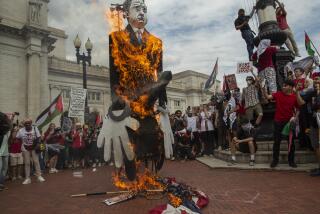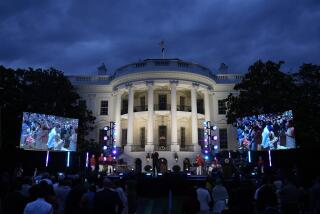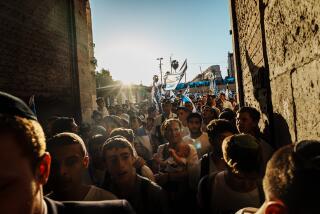Then and now, marchers speak their peace
Sitting in her dome tent with her weekend clothes crammed into plastic drawers, Barbara Cone Milazzo scanned the oddly young faces in her well-worn copy of the Silver Thread, reminiscing.
Of course, yearbook-gazing is par for the course at a 25-year reunion — but this wasn’t the kind of event where people crack up about the time someone put a cow in the principal’s office.
Milazzo was one of 150 or so campers gathered at Emma Wood State Beach in Ventura for the 25th anniversary of the Great Peace March, a near-disastrous, often exhilarating nine-month anti-nuke trek from Los Angeles to Washington, D.C.
At 47, Milazzo, an animated woman who runs after-school programs in Mariposa, Calif., has never attended any of her high school reunions. But she seldom misses get–togethers for the marchers, and the 25th — drawing a crowd from around the U.S. — was a must.
Nearby, someone played a guitar. Over at the food tent, there was laughter as a crew of ex-marchers prepared the evening’s burritos, suitable for both vegetarians and vegans. There would be campfires, singalongs, yoga classes, slide shows, trips to town, and quiet moments when middle-age marchers with kids and mortgages would reflect on what spurred them to trudge on.
For many people, it was a frightening time. The United States and the Soviet Union had engaged in nuclear brinkmanship for years. In 1983, President Reagan developed his “Star Wars” initiative, calling for development of an anti-missile system in space. “Nuclear winter” — a theoretical long-term toxic darkening of the skies after a nuclear attack — had tapped a deep vein of fear.
Milazzo remembers a recurring nightmare about a nuclear blast. “I was paralyzed with fear in high school,” she said. “The arms race made everything seem pointless.”
A couple of years later, she was in a health-food store when she saw a blurb about the upcoming march in Whole Life Times. Many miles hence, she was the group’s security director, succeeding a by-the-book military veteran and a woman whose approach was “too metaphysical” to maintain order among hundreds of tired, footsore activists.
About 1,800 marchers set out from Los Angeles on March 1, 1986. In a couple of weeks, the event’s organizers announced they were broke. Support vehicles were repossessed and the march stalled near Barstow, on a bicycle motocross track next to an auto junkyard. Most people went home, but about 500 of the original group stayed and, after marathon free-form debates, incorporated as Peace City, with a mayor, city council, finance department and press office.
There was a dentist with a chair in his van and a team of mediators to work out disputes. Old school buses were converted into rolling classrooms for children whose parents were marching. An impromptu comedy troupe tried to keep morale up, but it was a tough task; the punk-clad anarchists, for instance, bristled at the thought of name tags, let alone authority. At the reunion, more than one camper wryly noted that one of those young anarchists now teaches second grade.
For days, the crew at the beach swapped stories. There was the nine-day stretch of 90-degree days and 20-mile hikes with no showers. There was the epic storm that had marchers seeking refuge amid the stench of an abandoned fertilizer plant. And who could forget the wonderful cakes the children would gobble down when the group crossed state lines?
At points, they suffered the cruelty of strangers — mostly taunts of “Get a job!” or “Go to Russia!” In a few Nebraska towns, laundromats and grocery stores shut their doors when the marchers approached.
But more often they were surprised — shocked, even — by the goodwill they received from poor people, struggling farmers or just folks who showed up to take their pictures.
At the beach, Karen Doherty, chopping tomatoes for dinner, recalled the box of Snickers a good Samaritan provided outside of Barstow.
“They could have been bars of gold,” said Doherty, a resident director at Wellesley College in Massachusetts.
On Nov. 15, 1986, about 400 of the original marchers, accompanied by thousands of fresh recruits, reached Lafayette Park, across from the White House. Pete Seeger led the crowd in “This Land is Your Land.” Though the world did not disarm, the group had succeeded on a number of fronts: walking 3,701.4 miles, drawing international attention to the cause of peace, and, individually, expanding their lives.
“I learned I could stand on my own two feet and take care of myself,” said Julia Ziobro, now a technical writer in Bellevue, Wash. “I was 18 and that’s how I left home. My dad thought I was crazy and my mom slipped me a hundred bucks.”
At times, the reunion was something like a low-key Burning Man — a Glowing Man, perhaps. There was a mock wedding ceremony, with a marcher in drag and three others being “married” by an officiant who, scratching his head, said he now declared the happy quartet “this and this and this and that.” (On the march, three couples got married for real.) A “no-talent talent show” was scheduled for Saturday night.
There was also an observance for marchers who have died. Sixty of the original participants were over 60 at the time. And marchers attended a memorial on Saturday, the 66th anniversary of the atomic bombing of Hiroshima.
Whether a group like this could pull off a cross-country march today — even for the same cause — was an open question. Some said the atmosphere during the Cold War was warmer.
“We’d be seen as enemies of the state,” said Milazzo, adding that she once smuggled instructional books on community organizing and passive resistance into the Soviet Union. “We’d be domestic terrorists.”
Falling back into her old role as security director, she patrolled the Ventura campground at night, welcoming late arrivals and making sure nobody parked in no-parking zones. Via hand-held radio, she kept in touch with other members of the security team, who served the same function at campsite after campsite 25 years ago.
“The first night, I could have cried,” she said. “There was a glow from inside the tents and there were all these memories. It was so peaceful.”
More to Read
Sign up for Essential California
The most important California stories and recommendations in your inbox every morning.
You may occasionally receive promotional content from the Los Angeles Times.










